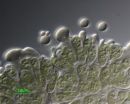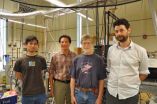(Press-News.org) LEXINGTON, Ky. − A team of researchers led by University of Kentucky College of Agriculture Professor Joe Chappell is making a connection from prehistoric times to the present that could result in being able to genetically create a replacement for oil and coal shale deposits. This could have fundamental implications for the future of the earth's energy supply.
Tom Niehaus, completing his doctorate in the Chappell laboratory; Shigeru Okada, a sabbatical professor from the aquatic biosciences department at the University of Tokyo; Tim Devarenne, a UK graduate and now professor of biochemistry and biophysics at Texas A&M University; and UK colleagues, Chappell, David Watt, professor of cellular and molecular biochemistry (College of Medicine) and his post-doctoral associate Vitaliy Sviripa had an important paper published today in the Proceedings of the National Academy of Sciences (PNAS). Their research findings go well beyond the basic science dealing with the origins of oil and coal.
While scientists previously established that oil and coal have their roots in the organisms that lived on the planet over 500 million years ago, researchers only are sure of one organism that directly contributed to these natural resources. That organism is the algae Botryococcus braunii which left behind its chemical fingerprints – an oil that over geological time has turned into oil and coal shale deposits.
"Even more exciting is that this unique algae, B. braunii, still exists today and has been the target of studies from the large chemical and petrochemical industries," said Chappell.
This algae is very slow growing, so it is not necessarily a good source for biofuels. However, if scientists can capture its genetic blueprints for the biosynthesis of these high value oils, then these genes could be used to generate alternative production platforms.
This team of investigators isolated the necessary genes, characterized the biochemical traits encoded by these genes, and then genetically engineered yeast to produce this very high-value oil. This work has provided the first example of recreating a true direct replacement for oil and coal shale deposits.
Chappell said, "This represents the culmination of an outstanding effort to understand a fundamental process that has direct ramifications for a real-world problem — how are we going to generate a truly renewable biofuel supply?"
Devarenne added, "This study identifies a very remarkable molecular mechanism for the production of hydrocarbons that, as far as we can tell, is not found in any other organism. Thus, it offers a unique insight into how hydrocarbons were produced hundreds of millions of years ago."
INFORMATION:
University of Kentucky-led research could be path to new energy sources
2011-07-12
ELSE PRESS RELEASES FROM THIS DATE:
New research shows forest trees remember their roots
2011-07-12
Toronto, ON - When it comes to how they respond to the environment, trees may not be that different from humans.
Recent studies showed that even genetically identical human twins can have a different chance of getting a disease. This is because each twin has distinct personal experiences through their lifetime.
It turns out that the same is likely true for forest trees as well, according to new research from the University of Toronto Scarborough (UTSC).
"The findings were really quite stunning," says Malcolm Campbell, a biologist and lead author of the study. "People ...
Multiple 'siblings' from every gene: Alternate gene reading leads to alternate gene products
2011-07-12
A genome-wide survey by researchers at The Wistar Institute shows how our cells create alternate versions of mRNA transcripts by altering how they "read" DNA. Many genes are associated with multiple gene promoters, the researchers say, which is the predominant way multiple variants of a given gene, for example, can be made with the same genetic instructions.
Their findings, which appear in the journal Genome Research, available online now, show how genes are read in developing and adult brains, and identify the changes in reading DNA that accompany brain development. ...
Researchers identify key role of microRNAs in melanoma metastasis
2011-07-12
Researchers at the NYU Cancer Institute, an NCI-designated cancer center at NYU Langone Medical Center, identified for the first time the key role specific microRNAs (miRNAs) play in melanoma metastasis to simultaneously cause cancer cells to invade and immunosuppress the human body's ability to fight abnormal cells. The new study is published in the July 11, 2011 issue of the journal Cancer Cell.
Researchers performed a miRNA analysis of human melanoma tissues, including primary and metastatic tumors. They found in both sets of tumor cells significantly high levels ...
Malaria parasites use camouflage to trick immune defences of pregnant women
2011-07-12
Researchers from Rigshospitalet – Copenhagen University Hospital – and the University of Copenhagen have discovered why malaria parasites are able to hide from the immune defences of expectant mothers, allowing the parasite to attack the placenta. The discovery is an important part of the efforts researchers are making to understand this frequently fatal disease and to develop a vaccine.
Staff member at CMP. Photo: Lars Hviid"We have found one likely explanation for the length of time it takes for the expectant mother's immune defences to discover the infection in the ...
Pitt team finds way to classify post-cardiac arrest patients to better predict outcomes
2011-07-12
PITTSBURGH, July 11 – A new method for scoring the severity of illness for patients after cardiac arrest may help to predict their outcomes, according to researchers at the University of Pittsburgh School of Medicine. Most importantly, their findings, published in the early online version of Resuscitation, also show that none of the severity categories rules out the potential for a patient's recovery.
"Traditionally, we have used historical or event-related information, such as initial cardiac rhythm or whether someone witnessed the collapse, to categorize these patients ...
Owl study expands understanding of human stereovision
2011-07-12
Rockville, Md. — Using owls as a model, a new research study reveals the advantage of stereopsis, commonly referred to as stereovision, is its ability to discriminate between objects and background; not in perceiving absolute depth. The findings were published in a recent Journal of Vision article, Owls see in stereo much like humans do.
The purpose of the study, which was conducted at RWTH Aachen (Germany) and Radboud University (Nijmegen, Netherlands), was to uncover how depth perception came into existence during the course of evolution.
"The reason why studying ...
Health-care practitioners' stories can aid medical device designers
2011-07-12
Health care laws to protect patients' privacy make it nearly impossible for medical device designers to develop and test the safety and usability of medical products by observing use in an actual practitioner-patient setting. As a result, usability errors and hazards may be overlooked, with the potential for devastating consequences. In the recent issue of Ergonomics in Design, human factors/ergonomics researchers found that storytelling as a qualitative research method was a more effective—and stimulating—way for health care practitioners to provide valuable insights during ...
Chicks dig certain types of music
2011-07-12
What accounts for the sounds we like to hear? Is it something about the properties of our auditory systems or brains? Or are such tastes learned? Two-month-old human infants show a preference for consonant, or gentler harmonies over more dissonant or harsher ones. But it's still impossible to know whether that preference is inborn, since the babies may have been exposed to certain sounds, even in utero.
Birds show similar behaviors: they can distinguish between different kinds of sounds and certain species are attracted to certain sounds. But because no one had experimented ...
Even before language, babies learn the world through sounds
2011-07-12
It's not just the words, but the sounds of words that have meaning for us. This is true for children and adults, who can associate the strictly auditory parts of language— vowels produced in the front or the back of the mouth, high or low pitch—with blunt or pointy things, large or small things, fast-moving or long-staying things.
Do the same principles apply for young infants, and not just to things, but also to abstractions? A new study by Marcela Peña, Jacques Mehler, and Marina Nespor, working together at the International School for Advanced Studies, in Trieste, ...
UC Riverside physicists discover new way to produce antimatter-containing atom
2011-07-12
RIVERSIDE, Calif. – Physicists at the University of California, Riverside report that they have discovered a new way to create positronium, an exotic and short-lived atom that could help answer what happened to antimatter in the universe, why nature favored matter over antimatter at the universe's creation.
Positronium is made up of an electron and its antimatter twin, the positron. It has applications in developing more accurate Positron Emission Tomography or PET scans and in fundamental physics research.
Recently, antimatter made headlines when scientists at CERN, ...

